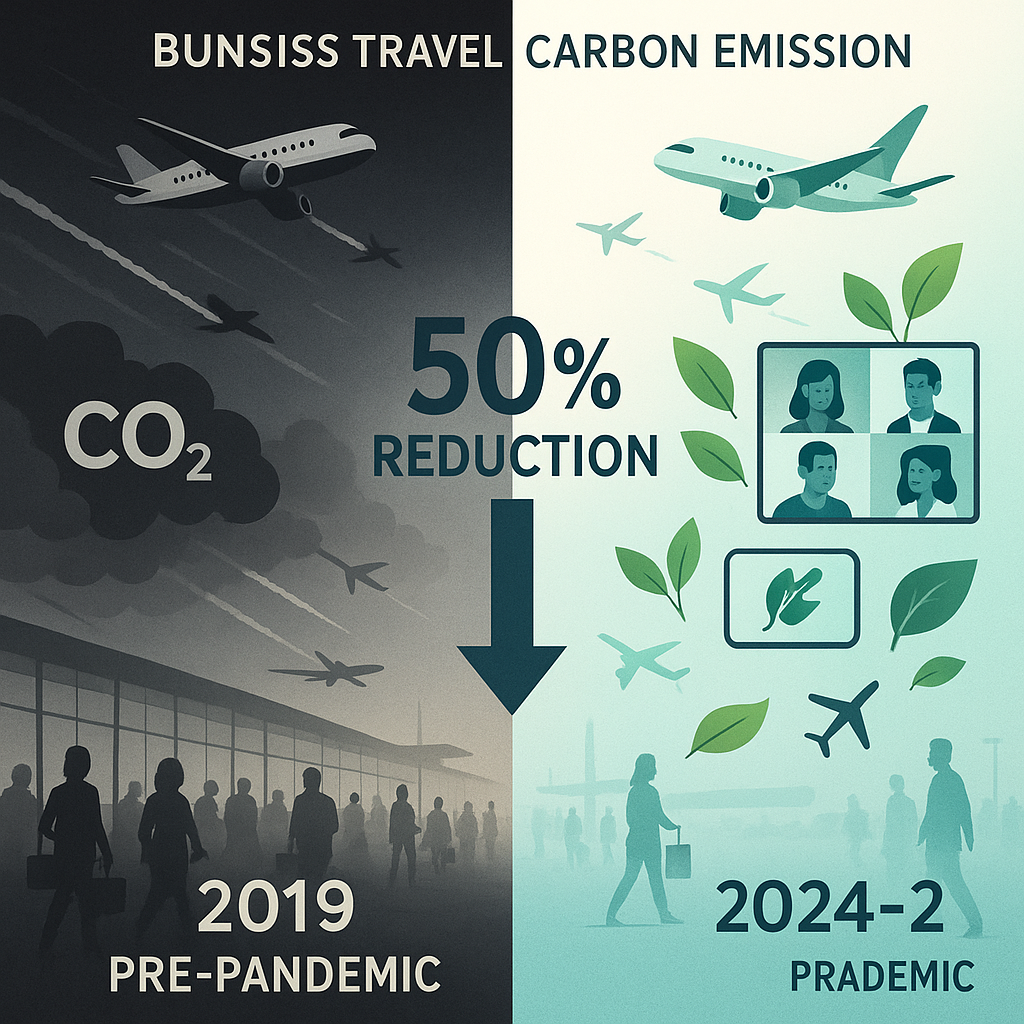The transformation of business travel’s environmental impact represents one of the most dramatic shifts in corporate sustainability practices of the modern era. While almost half of 217 global firms cut their business travel carbon emissions by at least 50% between 2019 and 2022, the landscape entering 2025 presents a complex paradox: emissions remain significantly below pre-pandemic levels even as travel demand rebounds to unprecedented heights.
This fundamental restructuring of corporate mobility patterns reflects not merely a temporary pandemic response, but a permanent recalibration of how organisations balance operational efficiency, environmental responsibility, and the evolving expectations of a hybrid workforce. The implications extend far beyond carbon accounting, influencing everything from real estate strategies to talent retention in an increasingly competitive global market.
The Great Emission Reduction: Quantifying the Transformation
The magnitude of business travel’s carbon footprint reduction cannot be overstated. Corporate air travel, which historically generated some of the highest per-passenger emissions in the transportation sector, experienced an unprecedented contraction that has proven surprisingly durable. Corporate travellers in Europe comprise about 12% of customers but are responsible for 30% of emissions, making their reduced activity disproportionately impactful on overall aviation emissions.
The broader aviation sector’s environmental footprint provides crucial context for understanding business travel’s role. In 2019, aviation accounted for 2.5% of CO2 emissions from fossil sources and land use, with business travel representing a significant portion of this total. The pandemic-induced travel restrictions contributed to a 10% reduction in U.S. GHG emissions compared to 2019, with corporate travel playing a central role in this decrease.
However, the emissions reduction story extends beyond simple volume decreases. Organisations have fundamentally altered their approach to business travel efficiency. Travelling economy class has half the CO2 footprint of business class, as passengers take up less space, and many corporations have implemented policies mandating economy travel for shorter flights while exploring sustainable aviation fuel options for essential long-haul business travel.
Remote Work’s Structural Impact on Travel Patterns
The permanent adoption of hybrid work models has created structural changes in business travel demand that transcend simple pandemic recovery metrics. According to a recent GBTA poll, nearly 60% of travel buyers expect more travel this year, with two-thirds anticipating increases in business travel spending, yet this growth occurs within a fundamentally transformed operational framework.
The implications for carbon emissions are nuanced. While absolute travel volume may be increasing, the purpose and efficiency of business trips have evolved significantly. Top program areas they are addressing related to remote / hybrid employees include types of meetings allowed for travel (40%) and frequency of travel to an office (32%), indicating that organisations are implementing sophisticated decision-making frameworks that prioritise high-value, in-person interactions while eliminating routine travel.

This strategic approach to travel authorisation has created what industry analysts term “purposeful mobility” – a paradigm where every business trip must demonstrate clear value propositions that justify its environmental cost. The result is fewer, but more intensive and productive business trips, often combining multiple objectives into single journeys to maximise efficiency while minimising carbon impact.
Remote work has also generated an unexpected category of business travel: the need to bring dispersed teams together for periodic collaboration. 27% said travel costs are “significantly or somewhat higher” to accommodate hybrid/remote workers, as organisations invest in bringing remote employees to central locations for strategic planning, team building, and collaborative projects that require in-person interaction.
Technology Integration and Meeting Transformation
The maturation of video conferencing technology has permanently altered the business travel landscape, creating what industry experts describe as a “digital-first, travel-when-necessary” approach to corporate communications. This transformation extends far beyond simple cost considerations to encompass fundamental changes in how organisations structure their operations and decision-making processes.
The sophistication of modern video conferencing platforms has eliminated entire categories of business travel that were previously considered essential. Routine meetings, quarterly reviews, training sessions, and even complex negotiations now occur seamlessly in digital environments, reserving in-person travel for activities that genuinely require physical presence: relationship building, complex problem-solving, cultural immersion, and hands-on technical work.
This technological integration has created measurable impacts on emission patterns. Organisations report that approximately 60-70% of previously routine business trips have been permanently replaced by digital alternatives, with the remaining travel focusing on high-value activities that justify their environmental cost. The result is a more intentional approach to business travel that treats each trip as a strategic investment rather than an operational routine.
Corporate Sustainability Mandates and Carbon Accounting
The business travel sector has become a critical battleground for corporate sustainability initiatives, with organisations facing increasing pressure from investors, regulators, and stakeholders to demonstrate measurable progress in emission reduction. Roughly 71 percent of respondents answered that they were personally concerned about the greenhouse gas emissions generated by their company as a result of travel, reflecting a fundamental shift in corporate consciousness around travel’s environmental impact.
This concern has translated into concrete policy changes. A comprehensive analysis of major corporations reveals that 193 were failing to act with sufficient speed and ambition to tackle travel emissions among 230 of the world’s largest companies, prompting accelerated action across the corporate sector. Organisations are implementing increasingly sophisticated carbon accounting systems that track, measure, and optimise travel-related emissions with unprecedented precision.
The integration of carbon considerations into travel approval processes represents a paradigm shift in corporate decision-making. Many organisations now require carbon impact assessments for all proposed business travel, with alternatives such as virtual meetings or regional representatives actively considered before approving high-emission trips. This approach has created a new category of corporate travel manager: the sustainability-focused travel coordinator who balances operational needs with environmental objectives.
Carbon offset programs have emerged as a critical component of corporate travel strategies, though with varying degrees of effectiveness and authenticity. Leading organisations are moving beyond simple offset purchases toward more comprehensive approaches that include sustainable aviation fuel procurement, partnership with environmentally progressive airlines, and investment in transportation infrastructure that supports lower-emission business travel options.
Economic Pressures and Budget Reallocation
The economic landscape of business travel has undergone fundamental restructuring, with organisations redirecting traditional travel budgets toward technology infrastructure and alternative engagement strategies. Industry stakeholders report their top 2024 concerns include the rising cost of travel (66 percent), overall economic concerns (46 percent), company budgets not keeping pace (42 percent), creating additional pressure for efficient, environmentally conscious travel planning.
This budget pressure has accelerated the adoption of emission-reducing travel practices, as organisations seek solutions that simultaneously address cost and environmental concerns. The result is increased investment in premium video conferencing technology, regional office spaces that reduce long-distance travel requirements, and strategic partnerships that enable local representation in key markets without requiring extensive corporate travel.
Looking Forward: 2025-2026 Industry Projections
The business travel industry entering 2025 faces a complex balancing act between emission reduction commitments and operational requirements in an increasingly globalised economy. 59% buyers expect the number of business trips will increase at their company in 2024 compared to 2023, yet this growth occurs within a framework of enhanced environmental accountability and technological sophistication.
Industry projections suggest that business travel emissions in 2025-2026 will stabilise at approximately 30-40% below 2019 levels, even as travel volume approaches 80-90% of pre-pandemic activity. This efficiency improvement reflects the permanent integration of hybrid work models, enhanced travel approval processes, and technological alternatives that have proven their effectiveness during the pandemic period.
The future of business travel carbon footprint reduction lies not in further volume decreases, but in continued efficiency improvements: sustainable aviation fuel adoption, enhanced carbon offset programs, strategic route optimisation, and the development of lower-emission transportation alternatives for regional business travel.
Organisations that successfully navigate this transformation will demonstrate that environmental responsibility and operational effectiveness are not competing priorities, but complementary strategies that drive innovation, efficiency, and competitive advantage in an increasingly sustainability-conscious global marketplace. The business travel sector’s carbon footprint reduction represents not just an environmental victory, but a fundamental reimagining of how modern organisations operate in a connected, yet environmentally conscious world.


